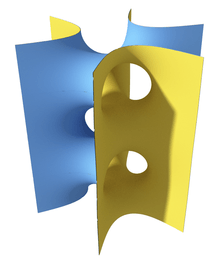K-noid


In differential geometry, a k-noid is a minimal surface with k catenoid openings. In particular, the 3-noid is often called trinoid. The first k-noid minimal surfaces were described by Jorge and Meeks in 1983.[1]
The term k-noid and trinoid is also sometimes used for constant mean curvature surfaces, especially branched versions of the unduloid ("triunduloids").[2]
k-noids are topologically equivalent to k-punctured spheres (spheres with k points removed). k-noids with symmetric openings can be generated using the Weierstrass–Enneper parameterization .[3] This produces the explicit formula
where is the Gaussian hypergeometric function.
It is also possible to create k-noids with openings in different directions and sizes,[4] k-noids corresponding to the platonic solids and k-noids with handles.[5]
References
- ↑ L. P. Jorge and W. H. Meeks III, The topology of complete minimal surfaces of finite total Gaussian curvature, Topology 22 (1983)
- ↑ N Schmitt (2007). "Constant Mean Curvature n-noids with Platonic Symmetries". arXiv:math/0702469
 .
. - ↑ Matthias Weber (2001). "Classical Minimal Surfaces in Euclidean Space by Examples" (PDF). Indiana.edu. Retrieved 2012-10-05.
- ↑ H. Karcher. "Construction of minimal surfaces, in "Surveys in Geometry", University of Tokyo, 1989, and Lecture Notes No. 12, SFB 256, Bonn, 1989, pp. 1-96" (PDF). Math.uni-bonn-de. Retrieved 2012-10-05.
- ↑ Jorgen Berglund, Wayne Rossman (1995). "Minimal Surfaces with Catenoid Ends". Pacific J. Math. 171 (2): 353–371. arXiv:0804.4203
 . Bibcode:2008arXiv0804.4203B. doi:10.2140/pjm.1995.171.353.
. Bibcode:2008arXiv0804.4203B. doi:10.2140/pjm.1995.171.353.
